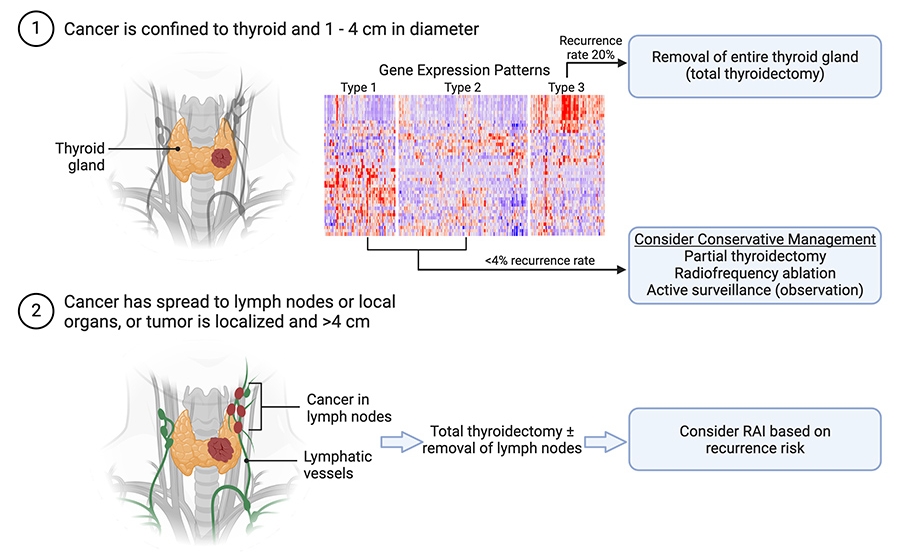- Management of papillary thyroid cancer (PTC) is guided by recurrence risk assessment.
- However, current risk estimation methods cannot accurately predict disease recurrence.
- Professor Oliver Bathe and his collaborators at the University of Calgary, Canada, developed a test that includes genetic data linked to recurrence.
- They identified three molecular PTC subtypes, allowing more accurate risk assessment to guide clinical decision-making and treatment.
Papillary thyroid cancer (PTC) is the most common type of thyroid cancer, accounting for about 80% of all thyroid cancer cases. PTC cases have risen markedly over time. The United States (US) Surveillance, Epidemiology, and End Results (SEER) database reported an increase from 4.8 to 14.9 per 100,000 people between 1975 and 2012, and other countries are similarly reporting increasing rates.

PTC usually spreads to nearby lymph nodes but rarely to other parts of the body. At diagnosis, about 10% of patients have metastases (spread from the original to secondary sites). Most PTC cases are curable with thyroidectomy (surgery to remove all or part of the thyroid gland). Some patients may require removal of affected lymph nodes. PTC is rarely life-threatening. However, in 10–20% of instances, the cancer will recur locally (in the neck) or at distant sites. Total thyroidectomy and radioactive iodine are offered to patients with PTCs that are at high risk of recurrence.
Challenges in managing PTC
Effective management of PTC relies on identifying which patients have an aggressive form of the disease. The American Thyroid Association (ATA) Risk Stratification system is the most widely used tool for guiding clinical decisions. The ATA system estimates the risk of disease recurrence based on clinical and pathological features – but it is inaccurate. This may be partly due to the inclusion of only one molecular marker (an identifying genetic characteristic), the BRAFV600E gene mutation. The role of the BRAFV600E gene mutation in predicting disease outcome is unclear. Moreover, risk estimates using the ATA system can only be made after surgery, limiting the system’s usefulness in planning how extensive surgery should be.
New insights from molecular research
A groundbreaking study by The Cancer Genome Atlas (TCGA) network, published in 2014, was a significant advance in understanding the genetic makeup of PTC. The study mapped the complete genetic profile of PTC in samples from patients in the US and identified two tumour types: BRAFV600E-driven tumours and RAS-mutated tumours.
Multivariate analysis revealed that molecular subtype and the presence of metastases were the strongest predictors of recurrence.
Professor Oliver Bathe and his colleagues at the University of Calgary, Canada, set out to find out how these PTC genetic types relate to clinical outcomes, especially features related to aggressive disease. Their goal was to create a molecular test that could more accurately predict the risk of recurrence and guide surgical decisions.
Using a proprietary machine learning algorithm, HighLifeRTM, the researchers analysed RNA sequencing (RNA-Seq) data from the TCGA study to identify genes related to recurrence risk. RNA-Seq gives a snapshot of the level of expression of genes in a sample. From over 20,000 genes in 502 PTC patients (of which 335 were used for discovery), they identified 82 genes linked to disease recurrence.
An unsupervised analysis of these 82 genes identified three unique subtypes of PTC, which the team named Type 1, Type 2, and Type 3. Unsupervised analysis uses machine learning algorithms to analyse unlabelled data to discover patterns independently without human involvement. The molecular subtypes showed noticeably different clinical and pathological characteristics, and these findings were confirmed using additional patient groups from South Korea and Canada.
Clinical and pathological characteristics of PTC subtypes
PTC has several histological (microscopic) cell variants. Type 1 PTCs consisted of mainly follicular variants and few tall cell variants, while Type 3 had the most tall cell variants. Type 2 and Type 3 histology was similar in that they mostly consisted of classical variants.
Type 1 PTCs had fewer BRAFV600E mutations and the highest rate of RAS (NRAS and HRAS) mutations. In contrast, BRAFV600E mutation rates were highest in Type 2 and Type 3. Telomerase reverse transcriptase (TERT) promoter mutations, which are linked to a higher risk of recurrence, were found in all three subtypes but were most common in Type 3 PTCs. Although Type 1 and Type 3 PTCs with TERT promoter mutations had high recurrence rates, Type 2 PTCs with TERT promoter mutations showed no recurrences.

Created in BioRender. Bathe, O, (2024) Biorender.com/n80e309
Type 2 and Type 3 PTCs, which were difficult to distinguish based on clinical and pathological features, had high rates of metastases to the lymph nodes and to distant sites. However, Type 3 PTCs had the highest risk of recurrence. Type 1 PTCs had smaller tumours and fewer lymph node metastases, which indicate less aggressive behaviour. Multivariate analysis revealed that molecular subtype and the presence of metastases were the strongest predictors of recurrence.
The researchers also applied their molecular test to anaplastic thyroid cancers (ATCs), which are rare, aggressive cancers with a high frequency of TERT promoter mutations and a poor prognosis. All ten cases had Type 3 molecular features.
Biological characteristics of PTC subtypes
What distinguished Type 1 PTCs was that they had significantly disordered lipid metabolism. Type 3 PTCs, and to a lesser extent Type 2 PTCs, showed increased activity (upregulation) in the EZH2 (enhancer of zeste homolog 2)-HOTAIR (HOXA transcript antisense RNA) pathway. This increased activity was linked to a microenvironment that suppressed the immune response. High EZH2 levels also play a role in tumour de-differentiation (reversal of specialisation), which is linked to a higher risk of recurrence and resistance to radioactive iodine therapy.

These findings highlight that molecular interactions may alter the effects of mutation. Therefore, understanding these processes provides a fuller picture of tumour behaviour than looking at mutations alone.
Implications for PTC management
Bathe and his colleagues found that their molecular subtype-based test, combined with tumour size and lymph node status, predicted recurrence more accurately than the ATA system. Their research has led to the development of a test that determines recurrence risk for PTC, Thyroid GuidePx®, guiding decisions about surgery.
Their research has led to the development of a test that determines recurrence risk for PTC, Thyroid GuidePx®, guiding decisions about surgery.
The test is designed to identify patients who can be treated with less extensive surgery, avoiding unnecessary complications and preserving quality of life. In low-risk cases, a range of treatments are available, including active surveillance and partial thyroidectomy. Studies are also emerging that are evaluating the role of radiofrequency ablation, a nonsurgical treatment. On the other hand, Thyroid GuidePx® ensures that high-risk patients are identified, so they can receive more aggressive therapy. Used after surgery, the test can help clinicians decide whether additional surgery or radioactive iodine (RAI) therapy is needed.
What inspired you to conduct this research?
As a surgical oncologist, I have frequently encountered situations where several treatment options are available, and the best option is not always obvious. There are also cases where toxic treatments are available, but the benefit to the individual patient is not known. For these reasons, we need better diagnostic tools to inform more personalised treatment decisions. My colleagues who are experts in thyroid cancer, Steve Craig and Adrian Harvey, brought to our attention the need for a test that will refine decision making for PTC. That is when we decided to apply our novel machine learning algorithm, HighLifeRTM, to address that unmet clinical need.
What further research needs to be done to validate the results from your study for use in the different populations of patients with papillary thyroid cancer or other types of thyroid cancer?
While we have tested the Thyroid GuidePx® algorithm on Korean patients, more data from other racial and ethnic groups will advance our understanding of how frequently each molecular subtype occurs. We will also need to understand how specific treatments affect outcomes in each molecular subtype.
How could the identification of these molecular subtypes of papillary thyroid cancer support the development of targeted therapies?
There are some features of the high-risk Type 3 subtype of PTC that are interesting from a therapeutic perspective. For example, drugs that block EZH2 may be effective in re-differentiating some PTCs, enhancing RAI-resistant cancers’ susceptibility to RAI therapy. There is also evidence in these tumours that the immune system is suppressed. This represents a rationale for investigating the role of immunotherapy in the future.











